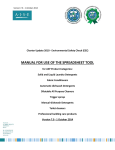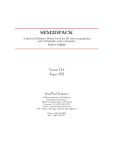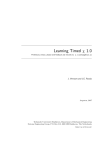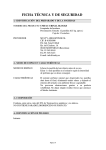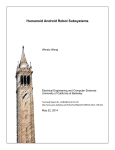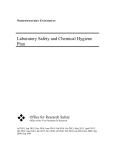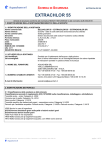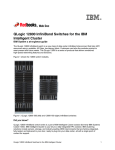Download Report - Transportation Research Board
Transcript
HMCRP HAZARDOUS MATERIALS COOPERATIVE RESEARCH PROGRAM REPORT 2 Sponsored by the Pipeline and Hazardous Materials Safety Assessing Soil and Groundwater Impacts of Chemical Mixture Releases from Hazardous Materials Transportation Incidents Administration TRANSPORTATION RESEARCH BOARD 2010 EXECUTIVE COMMITTEE* OFFICERS CHAIR: Michael R. Morris, Director of Transportation, North Central Texas Council of Governments, Arlington VICE CHAIR: Neil J. Pedersen, Administrator, Maryland State Highway Administration, Baltimore EXECUTIVE DIRECTOR: Robert E. Skinner, Jr., Transportation Research Board MEMBERS J. Barry Barker, Executive Director, Transit Authority of River City, Louisville, KY Allen D. Biehler, Secretary, Pennsylvania DOT, Harrisburg Larry L. Brown, Sr., Executive Director, Mississippi DOT, Jackson Deborah H. Butler, Executive Vice President, Planning, and CIO, Norfolk Southern Corporation, Norfolk, VA William A.V. Clark, Professor, Department of Geography, University of California, Los Angeles Eugene A. Conti, Jr., Secretary of Transportation, North Carolina DOT, Raleigh Nicholas J. Garber, Henry L. Kinnier Professor, Department of Civil Engineering, and Director, Center for Transportation Studies, University of Virginia, Charlottesville Jeffrey W. Hamiel, Executive Director, Metropolitan Airports Commission, Minneapolis, MN Paula J. Hammond, Secretary, Washington State DOT, Olympia Edward A. (Ned) Helme, President, Center for Clean Air Policy, Washington, DC Adib K. Kanafani, Cahill Professor of Civil Engineering, University of California, Berkeley Susan Martinovich, Director, Nevada DOT, Carson City Debra L. Miller, Secretary, Kansas DOT, Topeka Sandra Rosenbloom, Professor of Planning, University of Arizona, Tucson Tracy L. Rosser, Vice President, Corporate Traffic, Wal-Mart Stores, Inc., Mandeville, LA Steven T. Scalzo, Chief Operating Officer, Marine Resources Group, Seattle, WA Henry G. (Gerry) Schwartz, Jr., Chairman (retired), Jacobs/Sverdrup Civil, Inc., St. Louis, MO Beverly A. Scott, General Manager and Chief Executive Officer, Metropolitan Atlanta Rapid Transit Authority, Atlanta, GA David Seltzer, Principal, Mercator Advisors LLC, Philadelphia, PA Daniel Sperling, Professor of Civil Engineering and Environmental Science and Policy; Director, Institute of Transportation Studies; and Interim Director, Energy Efficiency Center, University of California, Davis Kirk T. Steudle, Director, Michigan DOT, Lansing Douglas W. Stotlar, President and CEO, Con-Way, Inc., Ann Arbor, MI C. Michael Walton, Ernest H. Cockrell Centennial Chair in Engineering, University of Texas, Austin EX OFFICIO MEMBERS Peter H. Appel, Administrator, Research and Innovative Technology Administration, U.S.DOT J. Randolph Babbitt, Administrator, Federal Aviation Administration, U.S.DOT Rebecca M. Brewster, President and COO, American Transportation Research Institute, Smyrna, GA George Bugliarello, President Emeritus and University Professor, Polytechnic Institute of New York University, Brooklyn; Foreign Secretary, National Academy of Engineering, Washington, DC Anne S. Ferro, Administrator, Federal Motor Carrier Safety Administration, U.S.DOT LeRoy Gishi, Chief, Division of Transportation, Bureau of Indian Affairs, U.S. Department of the Interior, Washington, DC Edward R. Hamberger, President and CEO, Association of American Railroads, Washington, DC John C. Horsley, Executive Director, American Association of State Highway and Transportation Officials, Washington, DC David T. Matsuda, Deputy Administrator, Maritime Administration, U.S.DOT Victor M. Mendez, Administrator, Federal Highway Administration, U.S.DOT William W. Millar, President, American Public Transportation Association, Washington, DC Tara O’Toole, Under Secretary for Science and Technology, U.S. Department of Homeland Security, Washington, DC Robert J. Papp (Adm., U.S. Coast Guard), Commandant, U.S. Coast Guard, U.S. Department of Homeland Security, Washington, DC Cynthia L. Quarterman, Administrator, Pipeline and Hazardous Materials Safety Administration, U.S.DOT Peter M. Rogoff, Administrator, Federal Transit Administration, U.S.DOT David L. Strickland, Administrator, National Highway Traffic Safety Administration, U.S.DOT Joseph C. Szabo, Administrator, Federal Railroad Administration, U.S.DOT Polly Trottenberg, Assistant Secretary for Transportation Policy, U.S.DOT Robert L. Van Antwerp (Lt. Gen., U.S. Army), Chief of Engineers and Commanding General, U.S. Army Corps of Engineers, Washington, DC *Membership as of October 2010. HAZARDOUS MATERIALS COOPERATIVE RESEARCH PROGRAM HMCRP REPORT 2 Assessing Soil and Groundwater Impacts of Chemical Mixture Releases from Hazardous Materials Transportation Incidents Richard G. Lewis Ziqi He HSA ENGINEERS & SCIENTISTS A Member of the Conestoga-Rovers & Associates Family of Companies Fort Myers, FL Subscriber Categories Highways • Motor Carriers • Railroads • Environment • Freight Transportation Geotechnology • Hydraulics and Hydrology Research sponsored by the Pipeline and Hazardous Materials Safety Administration TRANSPORTATION RESEARCH BOARD WASHINGTON, D.C. 2010 www.TRB.org HAZARDOUS MATERIALS COOPERATIVE RESEARCH PROGRAM HMCRP REPORT 2 The safety, security, and environmental concerns associated with transportation of hazardous materials are growing in number and complexity. Hazardous materials are substances that are flammable, explosive, or toxic or that, if released, produce effects that would threaten human safety, health, the environment, or property. Hazardous materials are moved throughout the country by all modes of freight transportation, including ships, trucks, trains, airplanes, and pipelines. The private sector and a diverse mix of government agencies at all levels are responsible for controlling the transport of hazardous materials and for ensuring that hazardous cargoes move without incident. This shared goal has spurred the creation of several venues for organizations with related interests to work together in preventing and responding to hazardous materials incidents. The freight transportation and chemical industries; government regulatory and enforcement agencies at the federal and state levels; and local emergency planners and responders routinely share information, resources, and expertise. Nevertheless, there has been a longstanding gap in the system for conducting hazardous materials safety and security research. Industry organizations and government agencies have their own research programs to support their mission needs. Collaborative research to address shared problems takes place occasionally, but mostly occurs on an ad hoc basis. Acknowledging this gap in 2004, the U.S. DOT Office of Hazardous Materials Safety, the Federal Motor Carrier Safety Administration, the Federal Railroad Administration, and the U.S. Coast Guard pooled their resources for a study. Under the auspices of the Transportation Research Board (TRB), the National Research Council of the National Academies appointed a committee to examine the feasibility of creating a cooperative research program for hazardous materials transportation, similar in concept to the National Cooperative Highway Research Program (NCHRP) and the Transit Cooperative Research Program (TCRP). The committee concluded, in TRB Special Report 283: Cooperative Research for Hazardous Materials Transportation: Defining the Need, Converging on Solutions, that the need for cooperative research in this field is significant and growing, and the committee recommended establishing an ongoing program of cooperative research. In 2005, based in part on the findings of that report, the Safe, Accountable, Flexible, Efficient Transportation Equity Act: A Legacy for Users (SAFETEA-LU) authorized the Pipeline and Hazardous Materials Safety Administration (PHMSA) to contract with the National Academy of Sciences to conduct the Hazardous Materials Cooperative Research Program (HMCRP). The HMCRP is intended to complement other U.S. DOT research programs as a stakeholder-driven, problem-solving program, researching real-world, day-to-day operational issues with near- to midterm time frames. Project HM-06 ISSN 2150-4849 ISBN: 978-0-309-15527-4 Library of Congress Control Number 2010941499 © 2010 National Academy of Sciences. All rights reserved. COPYRIGHT INFORMATION Authors herein are responsible for the authenticity of their materials and for obtaining written permissions from publishers or persons who own the copyright to any previously published or copyrighted material used herein. Cooperative Research Programs (CRP) grants permission to reproduce material in this publication for classroom and not-for-profit purposes. Permission is given with the understanding that none of the material will be used to imply TRB, AASHTO, FAA, FHWA, FMCSA, FTA, RITA, or PHMSA endorsement of a particular product, method, or practice. It is expected that those reproducing the material in this document for educational and notfor-profit uses will give appropriate acknowledgment of the source of any reprinted or reproduced material. For other uses of the material, request permission from CRP. NOTICE The project that is the subject of this report was a part of the Hazardous Materials Cooperative Research Program, conducted by the Transportation Research Board with the approval of the Governing Board of the National Research Council. The members of the technical panel selected to monitor this project and to review this report were chosen for their special competencies and with regard for appropriate balance. The report was reviewed by the technical panel and accepted for publication according to procedures established and overseen by the Transportation Research Board and approved by the Governing Board of the National Research Council. The opinions and conclusions expressed or implied in this report are those of the researchers who performed the research and are not necessarily those of the Transportation Research Board, the National Research Council, or the program sponsors. The Transportation Research Board of the National Academies, the National Research Council, and the sponsors of the Hazardous Materials Cooperative Research Program do not endorse products or manufacturers. Trade or manufacturers’ names appear herein solely because they are considered essential to the object of the report. Published reports of the HAZARDOUS MATERIALS COOPERATIVE RESEARCH PROGRAM are available from: Transportation Research Board Business Office 500 Fifth Street, NW Washington, DC 20001 and can be ordered through the Internet at: http://www.national-academies.org/trb/bookstore Printed in the United States of America COOPERATIVE RESEARCH PROGRAMS CRP STAFF FOR HMCRP REPORT 2 Christopher W. Jenks, Director, Cooperative Research Programs Crawford F. Jencks, Deputy Director, Cooperative Research Programs William C. Rogers, Senior Program Officer Charlotte Thomas, Senior Program Assistant Eileen P. Delaney, Director of Publications Ellen M. Chafee, Editor Rachel Kirkland, Senior Editorial Assistant HMCRP PROJECT 06 PANEL Thomas Moses, Spill Center, Hudson, MA (Chair) Craig Bartlett, DuPont Company, Wilmington, DE Cheryl A. “Cherry” Burke, Dow Chemical Company, Midland, MI Robert E. Fronczak, Association of American Railroads, Washington, DC Zdenek “Zed” Hejzlar, Engineering Systems, Inc., Fort Myers, FL John Walton, University of Texas - El Paso, El Paso, TX Ryan F. Paquet, PHMSA Liaison Christine Gerencher, TRB Liaison AUTHOR ACKNOWLEDGMENTS The research reported herein was performed under Dr. Richard G. Lewis, P.E., Principal at HSA Engineers & Scientists. Dr. Ziqi (Zeke) He, P.E., Environmental Engineer with HSA Engineers & Scientists, was responsible for the thermodynamic calculation and design tool. William H. Hutchings, P.G., Professional Geologist with HSA Engineers & Scientists and Ph.D. candidate at the University of South Florida, was responsible for fate transport modeling. Gordon L. Walters, P.E., Environmental Engineer at HSA Engineers & Scientists, was responsible for the tool interface design. Kevin W. Worsham, Database Developer with Conestoga-Rovers & Associates (CRA), and Julie Lidstone, Associate Database Manager with CRA, were responsible for visual basic coding of the tool design. Doug Soutter, Hydrogeologist with CRA, assisted with UNIFAC design. Dr. Hongze Gao, P.E., with CRA, assisted with the screening model design. Ronald Foster, Senior Processing Engineer with CRA, assisted with the data and methodology collection. In addition, the environmental department group at the office of HSA Engineers & Scientists in Fort Myers, Florida, and the emergency response team at CRA’s office in Dallas, Texas, participated in data collection of chemical properties and the most commonly transported hazardous materials. FOREWORD By William C. Rogers Staff Officer Transportation Research Board HMCRP Report 2: Assessing Soil and Groundwater Impacts of Chemical Mixture Releases from Hazardous Materials Transportation Incidents presents a tool to assess, classify, predict, and quickly communicate fate and transport characteristics of chemical mixtures released into the soil and groundwater as a result of hazardous materials transportation incidents. The tool was developed with a wide range of users in mind. For technical users, the property output table generates the fate and transport properties of an input mixture. For emergency response teams, it provides a quick review of the emergency response requirements of a spill. For non-technical users, a color-coding function is included in the tool to compare the critical fate and transport properties to their pure chemical counterpart and highlight the key parameters affecting the mixture transport in the saturated and unsaturated zones. The tool can also be used to determine whether shipping certain chemicals separately or in mixtures will have significantly higher costs if an incident occurs and to estimate relative costs and timeframes of cleanup after an incident occurs. Screening models, as well as detailed, computationally intensive models, exist to characterize site-specific impacts on soil and groundwater from hazardous materials releases. These models require various fate and transport parameters as input, which are generally available for pure chemical compounds. However, these parameters are typically unavailable for many of the commonly transported hazardous materials mixtures such as herbicides, paint, cleaning compounds, motor oil, antifreeze, gasoline, and ethanol. Under HMCRP Project 06, HSA Engineers & Scientists was asked to (1) define and categorize the environmental hazards to soil and groundwater of pure chemicals and mixtures; (2) identify sources and collect readily available data on fate and transport properties; (3) develop a typology and identify and classify common solvents and mixtures that are likely to be transported; (4) develop a typology to estimate the key parameters for different chemical mixtures; (5) design a tool to characterize, predict, and communicate the impact of chemical mixtures in soil and groundwater environments and to estimate the fate and transport parameters of chemical mixtures released to soil and groundwater as a result of hazardous materials transportation incidents; (6) using the tool, estimate the fate and transport parameters for 5 to 10 representative mixtures commonly transported and apply existing basic screening models to estimate impact to soil and groundwater; and (7) refine the tool to compare fate and transport characteristics of pure chemicals to chemical mixtures in order to rank the relative impacts to soil and groundwater. The chemical mixture tool, a user guide, and the contractor’s final report for HMCRP Project 06 can be found on CRP-CD-90: Chemical Mixture Tool for HMCRP Report 2, which is bound into this publication. For the convenience of readers, the research team’s Tool Design Process Example (Appendix H) and the User Operational Manual (Appendix M) are also provided herein. CONTENTS 1 Summary 6 Contents of Contractor’s Final Report for HMCRP Project 06 (Final Report Contained on CRP-CD-90) 9 Appendix H Tool Design Process Example 32 Appendix M User Operational Manual 54 List of Acronyms and Symbols 1 SUMMARY Assessing Soil and Groundwater Impacts of Chemical Mixture Releases from Hazardous Materials Transportation Incidents Introduction Each year, large quantities of hazardous materials are transported throughout the United States. In the event of an incident or accident, these hazardous materials can be released to the environment, thereby impacting soil and groundwater, leading to costly emergency response and cleanup efforts. Many impact measurement techniques in use today concentrate on fatalities/injuries, property damage, and emergency impacts, but exclude environmental and ecological impacts associated with releases into soil, groundwater, aquatic features, or natural habitats. Consequently, risk management decisions are being made in the absence of the comprehensive information necessary to mitigate long-term environmental risk. The screening model developed in this research is meant to aid in addressing this concern. As with all screening model requirements to assess the subsurface impact of hazardous materials, chemical-specific fate and transport data, as well as site-specific data, are necessary input parameters. While the fate and transport data are available for pure chemicals, similar data are not usually available for mixtures of hazardous materials that are commonly transported (e.g., herbicides, paint, cleaning compounds, motor oil, antifreeze, gasoline, and ethanol). The goal of this research was to develop a tool to estimate the critical fate and transport parameters of chemical mixtures for use in common fate and transport models, allowing the user to efficiently and effectively compare and predict the potential impacts of releases from transportation incidents. Specifically, the developed tool will assess, classify, predict, and quickly communicate fate and transport characteristics of chemical mixtures released into the soil and groundwater as a result of hazardous materials transportation incidents. The research team has completed 16 months of research on HMCRP Project 06, “Soil and Groundwater Impacts of Chemical Mixture Releases from Hazardous Materials Transportation Incidents.” A white paper submitted in June 2009 summarizes the preliminary efforts (Phase I, Tasks 1 to 4 outlined in the contract): • Task 1—define and categorize the environmental hazards to soil and groundwater of pure chemicals and mixtures, • Task 2—identify sources and collect readily available data on fate and transport properties, • Task 3—develop a typology and identify and classify common solvents and mixtures that are likely to be transported by the industry and significantly control or alter the hazardous material fate and transport properties, and • Task 4—develop a typology to estimate the key parameters for different chemical mixtures. 2 In September 2009, the research team proceeded to implement Phase 2 (Tasks 5 through 8) of the research project: • Task 5—design a tool to characterize, predict, and communicate the impact of chemical mixtures in soil and groundwater environments and to estimate the fate and transport parameters of chemical mixtures released to soil and groundwater as a result of hazardous materials transportation incidents; • Task 6—use the tool to estimate the fate and transport parameters for 5 to 10 representative mixtures commonly transported and to apply existing basic screening models to estimate impact to soil and groundwater; • Task 7—refine the tool to compare fate and transport characteristics of pure chemicals versus chemical mixtures in order to rank the relative impacts to soil and groundwater; and • Task 8—prepare a final report that fully explains the tool and documents the entire research effort, explains and justifies recommendations, provides background information used in the development of recommendations that addresses deficiencies and recommends further research. Consistent with the contract scope, the research team designed the tool using the typology table collected in Phase I as the database and refined the tool using the selected mixtures and existing screening models. The second phase of activity incorporated the data and opinions garnered in Phase I to develop the tool itself. This phase encompassed the design and construction of the tool, and the application of the tool to provide estimates of fate and transport values for several representative mixtures. The tool was then used to determine the effect of changes in these fate-and-transport parameters on the impact to soil and groundwater after a release. CRP-CD-90: Chemical Mixture Tool for HMCRP Report 2, provided with this publication, contains the chemical mixture tool, an operational manual for the tool, and the team’s final research report for HMCRP Project 06. Findings The summary of the literature review and expert interviews is provided for the top-ranked transported or spilled hazardous materials from the Spill Center; Association of American Railroads (AAR); Commodity Flow Survey (CFS); Conestoga-Rovers & Associates emergency response team; and the analysis of the incident reports database search from the Office of Hazardous Materials Safety in the U.S. DOT. Fuels and ethanol-blended fuels, alcohols, acids and bases, paints and related materials are the dominant hazardous material classes according to commodity transported and incidents reported. As identified in the interviews and literature review, the most important mixture is gasoline and ethanol. No clear second mixture was identified, although Not Otherwise Specified (NOS) mixtures clearly make up a large volume of what is transported. The research team has reviewed and assimilated numerous scientific articles and agency reports regarding chemical fate and transport and the methods for estimating the properties of mixtures, including Raoult’s Law, Universal Functional Activity Coefficient (UNIFAC), Cosolvency Effect, and Linear Solvation Energy Relationship (LSER). The approach to estimate the properties of chemical mixtures and the design of a tool have been provided for both ideal and non-ideal chemical mixtures. Considering that UNIFAC has been more versatile over other methods since it works for various solution systems, including those with high nonideality, the research team built a Microsoft Excel UNIFAC (xlUNIFAC) to function as the basis of the chemical mixture tool. This feature is a major strength of UNIFAC and is extremely valuable in estimating solubility of hydrophobic environmental contaminants 3 in multiple-component systems, which are very difficult to characterize experimentally. In the scenarios where xlUNIFAC does not function for a chemical mixture due to the lack of the molecular volume and surface area (i.e., Rk and Qk) or the group interaction parameters (i.e., anm), the cosolvent effects were incorporated into the tool as a second module to estimate the solubilities of chemicals in case of the presence of major cosolvents. A chemical mixture tool was developed to estimate the fate and transport properties of chemical mixtures using the xUNIFAC model, Raoult’s Law, and the Cosolvency—Log Kow Model. The tool is capable of modeling a mixture containing up to 29 components. Approximately 530 chemicals have UNIFAC group assignments, and the linear free energy relationships (LFERs) between the cosolvency power and log Kow are included for 15 completely water-miscible solvents, which are often used in industrial and environmental activities. The output table of the tool consists of the following: (1) chemical identification (name, CAS#, molecular weight), hazardous information (U.S. DOT Hazardous Class and UN/NA#); (2) mixture characteristics (mass percent, volume percent, mole fraction); and (3) physical chemical properties for the input mixture and its components (water solubility, vapor pressure, surface tension, viscosity, partitioning among mixture/water/air, partitioning between water and organic carbon/octanol, diffusion coefficients in air/water/mixture, and half-life time), which can be used to simulate the characteristics of non-aqueous phase liquid (NAPL) (where applicable) in soil, water, and air. In tests with 11 representative mixtures—including gasoline, methyl tertiary butyl ether (MTBE)-blended gasoline, ethanol-blended gasoline, coal tar, paint, ink, lacquer thinner, and drycleaner solvent—the tool has been versatile at estimating the fate and transport properties of hazardous mixtures. Hydrocarbon Spill Screening Model (HSSM), Multiphase Flow and Multicomponent Transport Model (MOFAT), and BIOSCREEN-AT are used as screening models to simulate the fate and transport of selected mixtures in subsurface. Benzene, toluene, ethylbenzene and xylene (BTEX), particularly benzene, was selected as the target compound to analyze the impact of ethanol and MTBE on gasoline based on the equivalent spill scenarios of oxygenate-free gasoline because benzene is the most mobile gasoline-derived contaminant that possesses significant toxicity and groundwater impact. Results indicated that the presence of 20% ethanol may cause a benzene plume in groundwater to be 30% longer than that in equivalent gasoline under anaerobic conditions, while there were no significant changes in benzene transport under aerobic biodegradation. The MTBE addition to gasoline does not significantly affect the gasoline component transport. However, the effect of MTBE itself on the environment is a concern due to MTBE’s high water solubility and low biodegradation under both aerobic and anaerobic conditions. Conclusions The chemical mixture tool was developed with a wide range of users in mind. For highly technical users, the property output table generates the fate and transport properties of an input mixture. For emergency response teams, the emergency response guide provides a quick review of the emergency response to a spill. For non-technical users, a color-coding function is included in the tool to compare the critical fate and transport properties to their pure chemical counterparts and highlight the key parameters affecting the mixture transport in the unsaturated (i.e., vadose) zone. A simplified version of Domenico’s model, designed by the research team, is included to simulate chemical fate and transport in groundwater. Without the availability of external screening models, the research team screening model can be applied directly to simulate the transport of a hazardous mixture in groundwater. Tool comparison, calibration, sensitivity analysis, and uncertainty analysis showed that the tool estimates mixture properties (e.g., interfacial tension and viscosity) within a mean 4 error of 30% and the NAPL-water interface properties (e.g., solubility and partition coefficient) within a maximum factor of 5.0, which is relatively small compared with the imprecise knowledge of subsurface gasoline release volumes and scenarios. When data are not available, this tool can be utilized to estimate the properties of a mixture. The tool results can be used to determine whether shipping certain chemicals separately or in mixtures will have significantly higher costs if an incident occurs, aiding in the emergency planning costs. The tool results can be used to estimate the relative costs and timeframes of cleanup after an incident occurs. The tool can also be used by remediation engineers to provide better remediation alternatives, given the availability of different properties of mixtures versus pure chemicals. For example, regulators and scientists could use the tool to estimate the properties of novel additives in future fuel formulations and thereby provide key inputs for determining the transportation facility upgrade and assessing environmental transport of these compounds using external screening models. Tool Limitations and Future Research Recommendations The main limitation of the tool is that it cannot be used for all chemical substances contained in the database of approximately 740 components derived from literary research and interviews with professional personnel based on hazardous material classification and commodity flow survey and incident reports. That said, data for new chemicals can be added as pure-phase information becomes available. The intended application domain is for liquid organic chemicals, particularly petroleum and related compounds. Inorganic and organometallic chemicals generally are outside the tool’s domain. Future work may be focused on the expansion of the typology table database to a larger database to simulate mixtures that consist of more chemicals. In addition, further research is needed to update the xlUNIFAC parameters with the latest available data. For example, as the largest database, the commercial UNIFAC still lacks parameters for some halogenated compounds and new pharmaceutical compounds. This study is focused on the mixture source zone property estimate. Therefore, the chemical property parameters were calculated based on the assumption that the NAPL and groundwater reach equilibria for individual components. The kinetic process of the interaction zone was not considered, and the interaction between the NAPL source zone and the dissolved plume in groundwater was not modeled in this study. For example, half-life time was produced by the tool for anaerobic and aerobic conditions from the typology table, which does not represent site-specific decay. Although the tool generates property parameters with a factor of 5.0, field assessment is necessary to further calibrate the tool for modification to simulate the field spill scenarios. The tool will not be able to assess the property changes with the temporal NAPL composition changes or the decay in the downgradient groundwater. For example, the rapid transfer of ethanol from gasoline into the water in the vadose zone (e.g., small volume spills) may not change the gasoline bulk transport properties (e.g., interfacial tension and viscosity) as predicted in this study. Furthermore, the quick degradation of ethanol in the groundwater will alter the cosolvency power, as well as the biodegradation of other components. Improved tool modification is required to integrate the mixture degradation in the field, especially the ethanol effect on the biodegradation of BTEX in the downgradient of the plumes. A screening model has been incorporated within the tool for the users to simulate the fate and transport in groundwater. However, the screening model results by HSSM and MOFAT indicate that the mixtures have dramatically different transport in the unsaturated zone due to changes in the density, interfacial tension, and viscosity. The behavior of the mixture in the unsaturated zone will significantly affect the groundwater fate and transport. Therefore, 5 combined with the existing groundwater model, further research is necessary to design a vadose zone screening model to simulate the mixture fate in subsurface based on the spill scenarios (e.g., spill volume, mixture component, and site-specific hydrogeologic setting). A user-friendly unit conversion may be included within the tool to export the tool results directly to the required form of screening models. Although the color-coding function is designed in the tool to compare the fate and transport characteristics of pure chemicals versus chemical mixtures in order to rank the relative impacts to soil and groundwater, future research is needed to compare the concentrations in subsurface to EPA clean up levels and to consider the cost and time frame of active remediation compared to natural attenuation. This module may be designed to estimate the cost of the most commonly used remedial approaches (e.g., groundwater pump-treat, air sparging, soil vapor extraction, chemical oxidation, and enhanced natural attenuation) at different time frames after the incident spills. The current version of the chemical mixture tool, provided on CRP-CD-90, was designed and tested to work with the PC version of Microsoft Excel. Additional research may be needed to modify the tool to work with a Mac system. 6 Contents of Contractor’s Final Report for HMCRP Project 06 (Final Report Contained on CRP-CD-90) LIST OF TABLES .......................................................................................................... iv LIST OF FIGURES ........................................................................................................ vi LIST OF ACRONYMS AND SYMBOLS ...................................................................... viii ABSTRACT .................................................................................................................... xi AUTHOR ACKNOWLEDGEMENTS ............................................................................ xi EXECUTIVE SUMMARY ......................................................................................... ES-1 CHAPTER 1. INTRODUCTION...................................................................................... 1 1.1 1.2 BACKGROUND .............................................................................................................. 1 SCOPE OF WORK .......................................................................................................... 2 CHAPTER 2. RESEARCH APPROACHES ..................................................................... 5 2.1 PHASE I APPROACHES ................................................................................................ 5 2.1.1 Task 1 Literature Review and Expert Interview ....................................................... 5 2.1.2 Task 2 Identify Data Sources and Collect Readily Available Data .......................... 7 2.1.2.1 External Electronic and Text Databases ............................................................ 7 2.1.2.2 Existing Software .............................................................................................. 8 2.1.2.3 Thermodynamic Calculation of Pure Chemicals ............................................... 8 2.1.2.4 Properties of Chemical Mixture ........................................................................ 8 2.1.3 Task 3 Tool Design Conceptual Model .................................................................... 8 2.1.3.1 “Lump” Component .......................................................................................... 8 2.1.3.2 Ideal Chemical Mixtures ................................................................................. 10 2.1.3.2.1 Solubility (Sm) of Chemical Mixture in Aqueous Phase..............................11 2.1.3.2.2 Effective Vapor Pressure (Pm) of Chemical Mixture ...................................11 2.1.3.2.3 Other Properties of Chemical Mixture..........................................................11 2.1.3.2.4 Partitioning between Chemical Mixture and Water Air Soil Phases ...........13 2.1.3.2.5 Degradation of Mixture Source (km) ............................................................14 2.1.3.3 Non-Ideal Chemical Mixtures ......................................................................... 14 2.1.3.3.1 Activity Coefficient in a Mixture Phase ......................................................15 2.1.3.3.2 Partitioning between Chemical Mixture and Water Air Soil Phases ...........15 2.1.3.3.3 Co-solvency Effect in Aqueous Phase .........................................................16 2.1.3.3.4 Salinity and pH Effect in Aqueous Phase ....................................................17 2.1.3.3.5 Effective Solubility (Sm) and Vapor Pressure (Pm) of Chemical Mixture ...18 2.1.3.3.6 Other Properties of Chemical Mixture.........................................................18 7 2.1.3.4 Review of Screening Models........................................................................... 18 2.1.3.5 Preliminary Design of the Tool and Communications .................................... 19 2.2 PHASE II APPROACHES............................................................................................. 21 2.2.1 Task 5 Chemical Mixture Tool (CMT) Design ...................................................... 69 2.2.1.1 Module 1 xlUNIFAC ....................................................................................... 69 2.2.1.1.1 Theoretical Background ...............................................................................69 2.2.1.1.2 Evaluation of xlUNIFAC .............................................................................77 2.2.1.2 Module 2 Cosolvency-Log Kow Model ........................................................... 78 2.2.1.2.1 Theoretical Background ...............................................................................78 2.2.1.2.2 Co-solvency power and log Kow Correlation Parameters ............................79 2.2.1.3 Module 3 Raoult’s Law ................................................................................... 80 2.2.1.4 Chemical Mixture Tool (CMT) Development................................................. 80 2.2.1.4.1 Input Interface ..............................................................................................81 2.2.1.4.2 Output Interface ...........................................................................................82 2.2.1.4.3 Example of Chemical Mixture Tool (CMT) Design....................................83 2.2.1.5 Emergency Response Guidance ...................................................................... 84 2.2.1.6 Modified Domenico Model ............................................................................. 84 2.2.1.6.1 Domenico Analytical Model Equation ........................................................84 2.2.1.6.2 Graphical Interface and Data Entry .............................................................85 2.2.1.6.3 Comparison to Existing Screening Models..................................................91 2.2.1.6.4 Graphical Plume Output and Application ....................................................92 2.2.1.6.5 Troubleshooting ...........................................................................................93 2.2.2 Task 6 Estimate the Fate and Transport Parameters for Representative Mixtures . 94 2.2.2.1 Representative Mixtures .................................................................................. 94 2.2.2.2 Tool Results of Representative Mixtures.......................................................... 94 2.2.2.3 Fate and Transport Modeling of Representative Mixtures ............................ 104 2.2.2.3.1 HSSM Simulation Results .........................................................................105 2.2.2.3.2 MOFAT Simulation Results ......................................................................116 2.2.2.3.3 BIOSCREEN-AT Simulation Results .......................................................130 2.2.2.4 Comparison and Analysis of Transport Properties and Simulation Characteristics.................................................................................................134 2.2.2.4.1 Analysis of HSSM Results for Gasoline....................................................134 2.2.2.4.2 Analysis of MOFAT Results for Gasoline.................................................143 2.2.2.4.3 Analysis of BIOSCREEN-AT Results for Gasoline..................................148 2.2.2.4.4 Summary of Screening Model Analysis ....................................................150 2.2.3 Task 7 and Task 8 Tool Refinement and Report .................................................. 151 2.2.3.1 Chemical Mixture Tool (CMT) Evaluation and Calibration ......................... 151 2.2.3.1.1 Viscosity Comparison ................................................................................152 2.2.3.1.2 Interfacial Tension Comparison.................................................................153 2.2.3.1.3 Partition Coefficient of BTEX into Water from Gasoline .........................154 2.2.3.1.4 Calibration and Verification of Total Effective Solubility ........................155 2.2.3.2 Sensitivity and Uncertainty Analysis of Chemical Mixture Tool (CMT) ..... 157 2.2.3.2.1 Sensitivity Analysis ...................................................................................157 2.2.3.2.2 Uncertainty Analysis..................................................................................159 2.2.3.3 Color Coding and Property Ranking ............................................................. 162 8 CHAPTER 3. FINDINGS AND APPLICATIONS ........................................................ 163 3.1 3.2 3.3 TYPOLOGY TABLE .................................................................................................. 163 CHEMICAL MIXTURE TOOL DESIGN AND APPLICATION.............................. 164 FATE AND TRANSPORT OF ETHANOL-BLENDED GASOLINE....................... 164 CHAPTER 4. CONCLUSIONS AND RECOMMENDATIONS .................................... 165 4.1 4.2 CONCLUSIONS.......................................................................................................... 165 LIMITATIONS AND FURTHER RESEARCH RECOMMENDATIONS................ 165 REFERENCES ............................................................................................................ 168 Appendix A. Interview Questionnaire and Interview List.......................................................... A-1 Appendix B. Collected Chemical Properties .............................................................................. B-1 Appendix C. Top-Ranked Hazardous Materials Reported for Incidents or Transported ........... C-1 Appendix D. Major UN# NOS Hazardous Materials ................................................................. D-1 Appendix E. Review of Screening Models..................................................................................E-1 Appendix F. Classification of Hazardous Materials Transported...............................................F-1 Appendix G. Evaluating UNIFAC, Cosolvency and LSER Methods ........................................ G-1 Appendix H. Tool Design Process Example............................................................................... H-1 Appendix I. Synthetic Gasoline and Retail Gasoline Compositions ............................................I-1 Appendix J. HSSM Simulation Results ....................................................................................... J-1 Appendix K. MOFAT Simulation Results.................................................................................. K-1 Appendix L. BIOSCREEN-AT Simulation Results ....................................................................L-1 Appendix M. User Operational Manual..................................................................................... M-1 9 APPENDIX H Tool Design Process Example 10 Mixture Input (Temperature and Volume, Weight or Mole Fraction) Raoult's Law Conversion of Volume, Weight and Mole Fraction xlUNIFAC Evaluation Yes Module 1 xlUNIFAC Reiteration Between mixture and Water till Fi , mw , n+1 − F i , mw , n Fi , mw , n × 100 ≤ 5% Estimate Viscosity, Diffusion Coefficients No Module 2 or 3 Presence of Cosolvents Yes No Module 2 Module 3 Cosolvency-Log K ow Raoult's Law Model Output of Mixture and Component Properties Emergency Response Guidance Fate & Transport Model (HSA Screening Model) Color Coding Export for other Applications Fate Model Upgrade Regulator Equipment Decision Final Tool Design Flow Chart for Mixture Properties Two examples are provided to elucidate the tool design process for the fate and transport properties of an input mixture as well as its components. One is for the Module 1 through a synthetic gasoline as a mixture example and the other is for Module 2 and 3 through a mixture of alcohols and chlorinated solvents. These design processes are hidden in the final tool and not formatted. In addition, emergency response guidance, HSA screening model, and the color-coding processes are not discussed in these two examples (details refer to the descriptions in the report for each section). The tool is designed to run the input mixture as a pseudo component NAPL. In order to compare the component properties in a mixture to its pure phase, the tool will also run each individual component as a 100% input. Shown below are the output table of the mixture and the pure components. Clearly, there are many calculation worksheets to obtain these final output tables. The number of the calculation step depends on the input mixture properties. Each step is provided below with notes of the calculation process beneath the tables (Equations are provided in the report). 11 Example 1. Synthetic Gasoline The mixture components and the mass fractions are shown in the Input Interface below. Mixture Input Interface of Example 1. 12 Output Table of Example 1. Pure Component Output Table of Example 1. 13 14 Tool Step 1 of Example 1. Tool Step 2_1 of Example 1. 15 16 Tool Step 2_2 of Example 1. Tool Step 3_1 of Example 1. 17 18 Tool Step 3_2 of Example 1. Tool Step 3_1(2) of Example 1. 19 20 Tool Step 3_2(2) of Example 1. Tool Step 3_2(Final) of Example 1. 21 22 Tool Step 3_1(3) of Example 1. Tool Step 3_1(4) of Example 1. 23 24 Tool Step 3_1(Final) of Example 1. Example 2. Chlorinated Solvents The mixture components and the mass fractions are shown in the Input Interface below. Input Interface of Example 2. 25 26 Output Table of Example 2. Pure Component Output Table of Example 2. 27 28 Step 1 of Example 2. Step 2_1 of Example 2. 29 30 Step 2_2 of Example 2. Step 3_1 of Example 2. 31 32 APPENDIX M User Operational Manual 33 TABLE OF CONTENTS 1. Requirements...................................................................................................................34 2. Starting the Program ......................................................................................................34 2.1. 2.2. 3. Excel 2003 .....................................................................................................................34 Excel 2007 .....................................................................................................................35 Tool Input and Execution...............................................................................................36 3.1. 3.2. 3.3. 4. Tool Input Parameters ...................................................................................................36 Reset the Tool................................................................................................................39 Running the Tool...........................................................................................................39 Output and Interpretation .............................................................................................39 4.1. 4.2. 4.3. 4.4. 5. Color Coding .................................................................................................................40 Parameter Notes ............................................................................................................42 Screening Model ...........................................................................................................43 Emergency Response Guidebook (ERG 2008) .............................................................45 Troubleshooting ..............................................................................................................46 5.1. 5.2. 5.3. 5.4. Adjusting Macro Security .............................................................................................46 Adding the ERROR Function for Screening Model .....................................................48 Spreadsheet-Related Problems ......................................................................................52 General ..........................................................................................................................53 34 1. REQUIREMENTS − Excel (Program tested using versions 2003 and 2007) − A Microsoft Windows PC (Currently not available in Mac) − At least 256 MB of system RAM − Recommended: 3.0+ Ghz CPU (2.0+ Ghz Parallel or Multi-core CPU) 2. STARTING THE PROGRAM The tool is designed in Excel using Visual Basic for Application (VBA), requiring Excel Macros to operate. Macros are written inside the tool to operate the toolbar buttons or help icons and repeat the steps of common calculations. 2.1. Excel 2003 Depending on your macro security settings, you may see one of the following three messages when you open the Excel file: 1) 2) 3) 35 If you see the first dialog box, please select the “Enable Macros” button and the tool will initialize. The second and the third dialogue boxes will require you to reduce your security level in Excel (Please see the troubleshooting section 5.1 for detailed assistance). Select the following: “Menu,” then “Tools,” then “Options,” then “Security,” and then click on “Macro Security.” Lower the security level to “Medium or Low.” This step requires that the user restart the Excel Software and reopen the Chemical Mixture Tool. Once the macro has been allowed to run according to the instructions above, the tool will show the front page in Excel as shown below. Clicking the “RUN CMT” button will show the input form and continue the tool process. 2.2. Excel 2007 Depending on your macro security settings, you may see the following warning when you open the Excel file: 36 Click the “Options” button, and then choose the option: “Enable this content.” Click “Okay.” If you do not see this item and did not receive the above warning, your security settings are too strict (please refer to the troubleshooting section 5.1 for assistance). Once the macro has been allowed to run per the above instructions, you should see the tool front page in Excel as below. Clicking the “RUN CMT” button will show the input form and continue the tool process. 3. TOOL INPUT AND EXECUTION 3.1. Tool Input Parameters Interface and Help Button 37 On the Tool input interface, click the “Help” button on the right top corner and the Help menu will open to illustrate the input interface functions as shown below. 1) 2) 3) 4) 5) 6) 7) 8) 9) 10) Mixture Name: Enter the mixture name. The default is “Mixture, m.” Temperature (Required): Enter the desired temperature. Temperature Unit: Unit of associated temperature. Default is Kelvin. Component Fraction: Method by which ratio of components will be defined. Page Selection: Once a certain number of components have been entered, additional pages will appear and can be toggled between here. Component Input: Enter the component by either name or CAS number. Ratio of Components: Based on (4), enter the amount of each component in the mixture. Function Buttons: 1. Search: Allows a search of the registry by CAS or name (details below). 2. Clear Selections: Resets the form. 3. Run: Begins the calculation process and produces output. Total: Displays the sum of (7). Must be 100 % by Mass or Volume; 1.0 by Molar Fraction for the tool to proceed. Reset Tool: Click to reset the tool at various mixture-water ratios. 38 11) Help: Illustrate the Input Interface and functions. Searching the Compound Registry When the “Search” button is clicked on the main form, the above window will open. Using the radio buttons, select which registry you would like to search. The drop down menu will allow you to limit the way in which you search the registry to items which begin with your data entry, items which end with your data entry, or items which contain your data entry at any point. After completing it, click the “Search” button on this form, and results will be displayed (note: entering nothing in the input box will result in all items in the registry being returned alphanumerically). To return a component to the main form, select it from the resulting list and click the “Add to Mixture” button. Only one anonym of a chemical is in the tool database, therefore, searching by CAS# will be the most convenient means to find an input component. If you do not see the component you are looking for, you may use the “Clear” button to reset this form and try again. If a desired chemical cannot be found either by chemical name or CAS# search, the desired chemical is not in the tool database. 39 3.2. Reset the Tool The nonaqueous phase liquid (NAPL)-groundwater interfacial equilibria are environmentally significant for the fate and transport of a solute in the field. The solubility or partitioning of a solute in a mixture is a function of the fraction of the compound in the mixture, the presence of cosolvents in the mixture, and the mixture-to-water ratio. For example, ethanol in ethanolblended gasoline will partition into aqueous phase and, only at certain concentration levels (i.e., 5% volume fraction in water), subsequently increase the solubility of hydrocarbons in gasoline. Conservatively, the tool sets the default NAPL-water volume ratio as 1:1 to simulate the scenarios of large volume spills or the near contaminant zone, where significant cosolvent may occur. The actual ratio may range from 1:1 to 1:10 depending on the incident scenarios. Every time when the tool is opened, it is automatically reset to a 1:1 ratio. Please enter the new ratio for other cases. 3.3. Running the Tool After the “Run” button is clicked on the main form, a series of simple checks will be performed to ensure the input is complete. If it is, an action bar and series of status messages will appear to inform you of the current action the tool is taking and to let you know that it is working. This may take several minutes based on the number of components, path through the tool, and CPU speed of your computer. 4. OUTPUT AND INTERPRETATION After the tool has finished running, an output interface will be displayed as shown as below. The default output page will provide a summary table of the fate and transport property parameters of your input mixture as well as a number of calculated values further to the right of what is shown here. In addition, there are four buttons (1 through 4) and a “Help” button (5) that will display a basic summary of each button’s function from within the tool itself. 40 4.1. Color Coding The "Color Coding” button (1) is designed to compare the properties of a component to its pure phase using different colors. Clicking the button will toggle the color coding on and off. The “Color Coding” button (1) will shade parameter Water Solubility through Anaerobic Half-Life time based on the specific parameter in that column in the mixture compared to that same parameter as a pure compound. • The Lime Green color represents the ratio of the property less than 5.0, which indicates that there are no significant changes in the property of the mixture compared to the pure chemical. • The Orange color represents the ratio of the property between 5.0 and 10.0, indicating that there are slight changes in the property of the mixture compared to the pure chemical. • The Red color represents the ratio of the property greater than 10.0, indicating that the chemical mixture may have a dramatic effect on the property of a component. • The Blue color highlights the major mixture NAPL transport properties in the unsaturated zone. 41 42 In addition, a note (shown above) will be added to each Orange/Red cell, which will show the associated value when the compound is not mixed as well as the ratio between the two. It should be noted that even though the color change from green to red indicates the severity of the property change of a component in a mixture compared to its pure phase, the red color does not guarantee the mixture is not acceptable considering the uncertainty of the tool. 4.2. Parameter Notes The "Parameter Notes" button (2) is designed to interpret the physical and chemical parameters and terms used in the output table. When this button is selected, a note box will open as below to 43 interpret the parameters and definitions in the output table. Click the “Return to Table” button to return to the output interface. 4.3. Screening Model The “Go to Component Plume” button (3) is designed to simulate a component plume in a saturated groundwater aquifer with default hydrogeologic characteristics. Select any component and then click the “Go to Component Plume” button and it will take the user to an interface of the Domenico Analytical Model designed by the research team, where a plume of the component is shown. The default simulation time is one year. The “Return to Table” button below the plume illustration will return the user to the main output sheet. Located to the right of the plume illustration are the entry parameters used to generate it. These are the generic parameters, which can be adjusted to fit the specific conditions in question. The concentration, partition coefficient, and half-life are calculated by the mixture tool (blue borders with a red font) and should not be changed. Please use the “Help” button below the input area to access detailed data entry instructions as shown below. Click the “Return to Plume” button to return to the screening model interface. 44 45 4.4. Emergency Response Guidebook (ERG 2008) The “Emergency Response Guide” button (4) is designed to assign each chemical component an Emergency Response Guidebook (ERG 2008), which was developed by the United States Department of Transportation (U.S. DOT). Select one component and click the “Emergency Response Guide” button, and it will take the user to the interface of appropriate emergency response guides according to the U.S. DOT Hazardous Class and United Nations Identification Number (UN#) assigned to the component for proper shipping as shown below. Clicking the “Return to Table” button at the bottom of the ERG will take the user to the current output interface. 46 5. TROUBLESHOOTING 5.1. Adjusting Macro Security Excel 2003: From the menu, select “Tools” then “Options” to open the above screen. Select the Security Tab from the groups at the top of this menu, and then click the “Macro Security” button from the bottom of the Security Tab. This will open the following menu: Here the user can change the security settings. “Medium” is the recommended setting which will result in the prompt mentioned above. A higher security setting will not allow the tool to run, and a lower security setting may allow potentially malicious macros to run without prompting, if the user is concerned. Once this setting has been changed, the tool must be closed and re-opened in order to proceed. 47 Excel 2007: Using the Office button (pictured to left) will show the following: Here, the user will select the highlighted button at the bottom (Excel Options), which will allow access to a number of application settings. On the next window, navigate first to the “Trust Center” (1), and then open the “Trust Center Settings” (2). 48 Finally, the user can change the security setting under “Macro Settings.” Selecting “Disable all macros with notification” is recommended and will result in the same behavior described in this document. Anything higher will prevent the tool from running, while anything lower will permit potentially malicious macros to run without prompt. Once this setting has been changed, the tool must be closed and re-opened in order to proceed. 5.2. Adding the ERROR Function for Screening Model The tool will automatically turn on the Analysis Toolpak in Excel as an Add-in to run the screening model. If it fails to turn on the ERROR Function in the Analysis Toolpak, a note will show as pictured below. If this function is not available, the data source calculations for the plume will result in “#VALUE!” Or “#NAME?” errors, and no chemical plume will be shown. 49 Next, install and load the Analysis ToolPak add-in following the instructions on the following page. Excel 2003: From the menu, select “Tools” and then “Add-Ins” to open the second screen below. From this menu, check the boxes next to both “Analysis ToolPak” and “Analysis ToolPak – VBA,” then click OK. Close Excel and reopen it, then run the Chemical Mixture Tool; the issue associated with the screening model plumes should be gone. 50 51 Excel 2007: Using the Office button (pictured to left) will show the following: Here, the user will select the highlighted button at the bottom (Excel Options) which will allow access to a number of application-wide settings. Once the “Options” window is open, select the “Add-Ins” tab on the right. This will display a window which looks like the image below. Select the “Go” button at the bottom of this window. 52 The following menu will open. Simply check the boxes next to “Analysis ToolPak” and “Analysis ToolPak – VBA,” then select “OK.” Close Excel and reopen it; then run the Chemical Mixture Tool, and the issue associated with the screening model plumes should be gone. 5.3. Spreadsheet-Related Problems The Tool was built in the Excel spreadsheet environment and spreadsheet-related problems may occur for either the cell/table format or the component plume due to the calculation process. Below are some anticipated problems and interpretations: 1) #### is displayed in a number box in the Output Table: The cell format is not compatible with the value, (e.g., the number is too big to fit into the window). To fix this, select the cell, pull down the format menu, select “Cells” and click on the “Number” tab. Change the format of the cell until the value is visible. If the values still cannot be read, select the format menu, select “Cells,” and click on the “Font” tab. Reduce the font size until the value can be read. 2) #DIV/0! is displayed in the raw data for the screening model plume: The raw data for the screening model is located in the bottom of the screening model interface. The most common cause of this problem is that some input data in the screening model are missing. In some cases, entering a zero in a box will cause this problem. Doublecheck to make certain that all of the input cells required for your run have data. In addition, as described in 5.2, the ERROR Function required for the Screening Model may cause this issue (Please see the troubleshooting section 5.1 for detailed assistance). 53 3) The plume graphs seem to move around or change size: The screening model plume is generated by Excel Standard Chart Wizard. This is a feature of Excel. When graph scales are altered to accommodate different plotted data, the physical size of the graphs will change slightly, sometimes resulting in a graph that spreads out over the fixed axis legends. The research team has adjusted the graph scale (i.e., axis scale and the plume display contours) according to the plume sizes. However, users still can manually resize the graph to make it look nice again by double-clicking on the graph and resizing it (refer to the Excel User’s Manual). 5.4. General Most unexpected, abnormal behavior can be resolved by: • • • Restarting Excel, Rebooting your computer, or Returning to the original zipped document and re-extracting a fresh copy of the tool. This tool’s main limitation is that it cannot be used for all chemical substances, with the database of 740 components derived from literary research and interviews with professional personnel based on hazardous material classification and commodity flow survey and incident reports. The intended application domain is for liquid organic chemicals, particularly petroleum and related compounds. Inorganic and organometallic chemicals generally are outside the tool’s domain. If the desired chemical is out of the tool database, the current tool will not be able to generate the property for the particular mixture and simulate the fate and transport in subsurface. Detailed information concerning the development, performance, and application of the tool, as well as the individual programs (e.g., Universal Functional Activity Coefficient (UNIFAC) model, Raoult’s Law, and the Cosolvency-Log Kow Model) contained within it, can be found within the theoretical section of the tool development manual. If there are any issues that are not resolved by the manual, please contact HSA Engineers & Scientists at (239) 936-0789 or [email protected] . 54 LIST OF ACRONYMS AND SYMBOLS AAR API ATSDR BTEX BTS CAMEO CAS # CFS CHEMTREC DGAC DNAPL DOE DOT EAWAG EPA EPIWIN FDEP FGCU HAZMAT HMCRP HSDB HSSM IAFC IRIS ISI IUPAC KOPT LFER LNAPL LSER LSST MHMI MIT MOFAT MSDS NAPL Association of American Railroads American Petroleum Institute Agency for Toxic Substances & Disease Registry benzene, toluene, ethylbenzene, and xylene Bureau of Transportation Statistics Computer-Aided Management of Emergency Operations Chemical Abstract Service registry number, which is unique identification for chemicals. It is also referred to as CAS RN. Commodity Flow Survey Chemical Transportation Emergency Center Dangerous Goods Advisory Council Dense Non-aqueous Phase Liquid U.S. Department of Energy U.S. Department of Transportation Swiss Federal Institute for Environmental Science and Technology U.S. Environmental Protection Agency Estimation Program Interface Suite Florida Department of Environmental Protection Florida Gulf Coast University Hazardous Materials Hazardous Materials Cooperative Research Program Hazardous Substance Data Bank Hydrocarbon spill screening model International Association of Fire Chiefs Integrated Risk Information System Institute for Scientific Information International Union of Pure and Applied Chemistry Kinematic Oily Pollutant Transport Linear Free Energy Relationship Light non-aqueous phase liquids Linear Solvation Energy Relationship Linear Solvation Strength Theory Managing Hazardous Materials Incident Massachusetts Institute of Technology Multiphase Flow & Multicomponent Transport Model Material Safety Data Sheets Non-aqueous Phase Liquid 55 NIST NOS NTSB OPP TRB TSG UN/NA # Aerobic t1/2 Anaerobic t1/2 Da Dw Dm foc I K Ki, am Ki, aw Ki, mw Ki, oc Kow MW ρ σ σow P S η σi,j γ Cs C0 αx αy αz λ ks θe θ− R National Institute of Standards and Technology Not Otherwise Specified National Transportation Safety Board Office of Pesticide Programs Transportation Research Board Transient Source Gaussian Plume United Nations or North American Identification Numbers The half-life time of a component under aerobic conditions. The smaller the half-life time, the faster the chemical decay. The half life time of a component under anaerobic conditions Diffusion coefficient in air Diffusion coefficient in water Diffusion coefficient in mixture Fraction organic carbon Hydraulic gradient (ft/ft) Hydraulic conductivity (ft/yr) Partition coefficient between air and the mixture, which is relevant for phase equilibrium and the concentration in air Partition coefficient between air and water (unitless) Partition coefficient between the mixture and water, which is relevant for phase equilibrium and the solubility in water Partition coefficient of a component between organic carbon and water, which is relevant for adsorption of a NAPL to sediment and the retardation factor of a NAPL travel velocity Partition coefficient between octanol and water Molecular weight of the component, which is unique for each chemical Density Surface tension of a NAPL against air The interfacial tension between the mixture and water Vapor Pressure The solubility in water Dynamic viscosity As the co-solvency power of the solvent for the compound i in co-solvent j Activity Coefficient Concentration in Source Zone (mg/L) Concentration in Source Zone at t=0 (mg/L) Longitudinal groundwater dispersivity (ft) Transverse groundwater dispersivity (ft) Vertical groundwater dispersivity (ft) First-order decay coefficient for dissolved contaminants (yr−1) First-order decay term for source concentration (yr−1) (no decay for the source concentration based on the assumption of continuous source plume) Effective soil porosity Soil total porosity Constituent retardation factor Abbreviations and acronyms used without definitions in TRB publications: AAAE AASHO AASHTO ACI–NA ACRP ADA APTA ASCE ASME ASTM ATA ATA CTAA CTBSSP DHS DOE EPA FAA FHWA FMCSA FRA FTA HMCRP IEEE ISTEA ITE NASA NASAO NCFRP NCHRP NHTSA NTSB PHMSA RITA SAE SAFETEA-LU TCRP TEA-21 TRB TSA U.S.DOT American Association of Airport Executives American Association of State Highway Officials American Association of State Highway and Transportation Officials Airports Council International–North America Airport Cooperative Research Program Americans with Disabilities Act American Public Transportation Association American Society of Civil Engineers American Society of Mechanical Engineers American Society for Testing and Materials Air Transport Association American Trucking Associations Community Transportation Association of America Commercial Truck and Bus Safety Synthesis Program Department of Homeland Security Department of Energy Environmental Protection Agency Federal Aviation Administration Federal Highway Administration Federal Motor Carrier Safety Administration Federal Railroad Administration Federal Transit Administration Hazardous Materials Cooperative Research Program Institute of Electrical and Electronics Engineers Intermodal Surface Transportation Efficiency Act of 1991 Institute of Transportation Engineers National Aeronautics and Space Administration National Association of State Aviation Officials National Cooperative Freight Research Program National Cooperative Highway Research Program National Highway Traffic Safety Administration National Transportation Safety Board Pipeline and Hazardous Materials Safety Administration Research and Innovative Technology Administration Society of Automotive Engineers Safe, Accountable, Flexible, Efficient Transportation Equity Act: A Legacy for Users (2005) Transit Cooperative Research Program Transportation Equity Act for the 21st Century (1998) Transportation Research Board Transportation Security Administration United States Department of Transportation

































































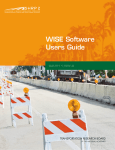

![2013 Gun List internet copy[2]](http://vs1.manualzilla.com/store/data/005851443_1-16b4e1bd3fc391c408d2005c48a2e336-150x150.png)

